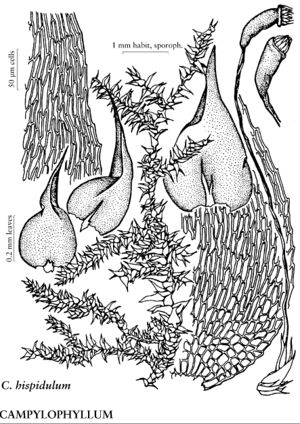Campylophyllum
Nova Guinea 12: 123. 1914.
| Taxon | Illustrator ⠉ | |
|---|---|---|
 | Campylophyllum hispidulum | Patricia M. Eckel |
Plants small or minute, green, yellow-green, yellowbrown, or brown. Stems irregularly branched to pinnate; hyalodermis absent, central strand narrow or absent; paraphyllia absent or few; rhizoids or rhizoid initials on stem or abaxial costa insertion, rarely forming tomentum, slightly or strongly branched, smooth or slightly warty-papillose; axillary hair distal cells 1–6, hyaline. Stem-leaves recurved or squarrose, sometimes slightly homomallous, cordate or narrowly to broadly ovate, not or near base slightly plicate, to 1 mm; base decurrent or not; margins plane or near base recurved, denticulate or entire, limbidia absent; apex acuminate or narrowly so, acumen furrowed; costa double, short, distal abaxial surface sometimes rough or terminal spine present; alar cells differentiated, small, region distinctly or indistinctly delimited, quadrate, isodiametric, oblong, or broadly ovate, along margin; medial laminal cells elongate-hexagonal to linear; distal cells sometimes prorate distally on dorsal side; marginal cells 1-stratose. Sexual condition autoicous. Capsule ± horizontal, cylindric, ± curved; peristome perfect; exostome margins dentate or slightly dentate distally; endostome cilia 1–3, well developed, nodose. Spores 8–18 (–21) µm.
Distribution
North America, Mexico, South America, Eurasia
Discussion
Species 10 or 11 (3 in the flora).
Campylophyllum grows on at least periodically dry calcareous rock and soil, or on organic substrates. In size and microscopic features, Campylophyllum is similar to certain Hypnum species, such as H. pallescens and H. recurvatum, rather than to species of Campyliadelphus or Campylium despite striking differences in leaf orientation.
Selected References
None.
Key
| 1 | Stem leaves densely inserted, strongly squarrose, hardly changing when dry; bases erect-spreading; leaves 0.3-0.7 mm wide; acumina 32-45% leaf length; alar regions small, reaching from margin 20-35% distance to costa at insertion; paraphyllia present, few; axillary hair distal cells 1-6, rectangular or shortly so. | Campylophyllum halleri |
| 1 | Stem leaves densely or sparsely inserted, ± recurved, sometimes more erect when dry; bases erect to almost spreading; leaves 0.2-0.5 mm wide; acumina 40-62% leaf length; alar regions large, reaching from margin 40-65% distance to costa at insertion; paraphyllia absent; axillary hair distal cells 1-3, linear or shortly so | > 2 |
| 2 | Stem leaf distal alar cells usually rectangular, or transversely rectangular or quadrate, basal alar cells short-rectangular, sometimes rectangular, alar regions reaching from margin 50-65% distance to costa at insertion; setae 0.9-1.7 cm. | Campylophyllum hispidulum |
| 2 | Stem leaf distal alar cells quadrate to rectangular, basal alar cells long- to short-rectangular, alar regions reaching from margin 40-50% distance to costa at insertion; setae 1.2-2.2 cm. | Campylophyllum sommerfeltii |
"narrower" is not a number.